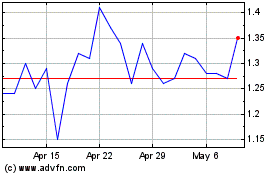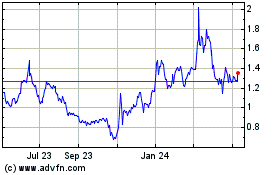Clearside Biomedical, Inc. (Nasdaq:CLSD), a biopharmaceutical
company revolutionizing the delivery of therapies to the back of
the eye through the suprachoroidal space (SCS®), announced today
positive safety results from OASIS, its ongoing Phase 1/2a clinical
trial of CLS-AX (axitinib injectable suspension) administered by
suprachoroidal injection via Clearside’s SCS Microinjector®. OASIS
is evaluating CLS-AX for the treatment of neovascular age-related
macular degeneration (wet AMD).
Data reported today includes results from Cohort
2 as well as combined data from Cohorts 1 and 2. The primary
endpoints were achieved in Cohort 2 (n=5), as the 0.1 mg dose of
CLS-AX was well tolerated with no serious adverse events; there
were no treatment emergent adverse events related to aflibercept,
CLS-AX or the suprachoroidal injection procedure; and there was no
dispersion of drug into the vitreous. In addition, there were no
adverse events related to intraocular pressure (IOP), inflammation,
or vasculitis. The OASIS Safety Monitoring Committee has reviewed
the data and approved advancing to Cohort 3 with a dose of 0.5 mg
of CLS-AX.
Thomas A. Ciulla, M.D., MBA, Chief Medical
Officer and Chief Development Officer, commented, “Our OASIS trial
continues to demonstrate positive safety results as we escalate the
dose. Given that this trial represents the first time a tyrosine
kinase inhibitor has been injected suprachoroidally in humans, we
started OASIS with low dose levels to establish a foundation for
safety. We believe the absence of any dose limiting toxicities in
the first two cohorts of the OASIS trial, combined with our
pre-clinical toxicology data, supports our plan to escalate to the
higher CLS-AX dose of 0.5 mg in Cohort 3 rather than the previous
0.3 mg dose. We have initiated patient screening for Cohort 3, with
target completion of this cohort planned for mid-year 2022. We look
forward to gathering more data on the potential benefits of
combining targeted and compartmentalized suprachoroidal delivery
with the broad pan-VEGF attributes of axitinib for patients
suffering from wet AMD.”
Data Summary
In Cohort 2, five patients were enrolled with an
average age of 78 years. All patients were anti-VEGF
treatment-experienced, having undergone numerous injections of
standard-of-care anti-VEGF treatments prior to entering the OASIS
trial. The mean number of anti-VEGF treatments prior to the start
of the trial was 9.2 injections within twelve months and 21.6
injections within 3 years. In Cohort 2, at three months post CLS-AX
dose, one patient did not require any retreatment and one other
patient was retreated per protocol defined retreatment criteria.
Two patients were retreated at month two and one patient was
retreated at month one, although based on independent reading
center assessment, the protocol defined retreatment criteria were
not met in these three patients.
In the combined Cohorts 1 and 2, eleven patients
were enrolled with an average age of 80 years. The mean number of
anti-VEGF treatments prior to the start of the trial was 9.1
injections within twelve months and 22.1 injections within 3 years.
In the combined cohorts: four patients (36% of the total) went at
least three months post CLS-AX dosing without retreatment; six
patients (55% of the total) went two months without retreatment;
and one patient (9% of the total) was retreated at one month. The
mean best corrected visual acuity (BCVA) score as measured by Early
Treatment Diabetic Retinopathy Study (ETDRS) letters and the mean
change in central subfield thickness (CST) of the macula were
stable in the combined first two cohorts of the OASIS study.
“The suprachoroidal injection procedure has been
easy to perform, reliable and well tolerated by patients during
this study. The consistent safety data from Cohorts 1 and 2 support
escalation to higher dosing, which we anticipate will provide
further insights related to safety, visual acuity, ocular anatomy
and durability,” added Mark R. Barakat, M.D., Director of Research,
Retinal Consultants of Arizona, and Clinical Assistant Professor,
University of Arizona College of Medicine, Phoenix, and an
investigator in the OASIS clinical trial.
Conference Call & Webcast
Details
Clearside will host a webcast and conference
call with accompanying slides today at 8:30 a.m. ET, including
comments by management and retinal expert, Peter Kaiser, M.D.,
Chaney Family Endowed Chair for Ophthalmology Research and a
Professor of Ophthalmology at the Cleveland Clinic Lerner College
of Medicine, and a member of Clearside’s Scientific Advisory Board.
The live and archived webcast may be accessed on the Clearside
website under the Investors section: Events and Presentations. The
live call can be accessed by dialing 844-263-8310 (domestic) or
213-358-0959 (international) and entering conference code:
7369695.
OASIS Phase 1/2a Clinical Trial
Design
OASIS is an open-label, dose-escalation Phase
1/2a trial in wet AMD patients to assess the safety and
tolerability of a single dose of CLS-AX administered by
suprachoroidal injection via Clearside’s SCS Microinjector®.
Eligible patients are those who demonstrate stable visual
acuity following two or more previous injections with an
intravitreal anti-VEGF agent. All enrolled patients undergo
diagnostic imaging on screening, followed by masked reading center
confirmation of persistent active disease.
Enrolled patients initially receive aflibercept
at the first visit followed by a single dose of CLS-AX at the
second visit one month later. The primary endpoint for the trial
will assess the safety and tolerability of CLS-AX for the three
months following the administration of CLS-AX, and secondary
endpoints will evaluate the pharmacokinetics, visual function,
ocular anatomy, and the need for additional treatment with
intravitreal aflibercept during the three-month period.
The study design includes 3 cohorts of
approximately 5 patients each (n=15). Cohorts 1 and 2 are complete.
Cohort 1 and Cohort 2 participants received 0.03 mg and 0.1 mg of
axitinib, respectively. Cohort 3 is currently enrolling
participants for a planned dose of 0.5 mg of axitinib delivered via
suprachoroidal injection. There is also a three-month extension
study to follow patients in Cohorts 2 and 3. Additional information
on the Phase 1/2a trial can be found on https://clinicaltrials.gov
(NCT04626128).
About CLS-AX (axitinib injectable
suspension)
CLS-AX (axitinib injectable suspension) is a
proprietary suspension of axitinib for suprachoroidal injection.
Axitinib is a tyrosine kinase inhibitor (TKI) currently approved to
treat renal cell cancer that achieves pan-VEGF blockade, directly
inhibiting VEGF receptors-1, -2, and -3 with high potency and
specificity. Clearside believes this broad VEGF blockade may have
efficacy advantages over existing retinal therapies by acting at a
different level of the angiogenesis cascade, and may benefit
patients who sub-optimally respond to current, more narrowly
focused anti-VEGF therapies. Suprachoroidal injection of this
proprietary suspension of axitinib has demonstrated meaningful
potential in preclinical studies in multiple species. Preclinical
results from Clearside and independent investigators have shown
pharmacodynamic effects with reduced growth of experimental
neovascularization and decreased fluorescein leakage. With
suprachoroidal administration of axitinib, there is the potential
to achieve prolonged duration and targeted delivery to affected
tissue layers. Clearside is developing CLS-AX as a long-acting
therapy for the treatment of wet AMD.
About Neovascular Age-Related Macular
Degeneration (wet AMD)
Age-related macular degeneration causes a
progressive loss of central vision and is the most common cause of
legal blindness in individuals over age 55. Wet AMD is generally
caused by abnormal blood vessels that leak fluid or blood into the
macula, the part of the retina responsible for central vision, and
accounts for the majority of vision loss in patients with this
disorder. In the U.S., approximately 11 million patients are living
with AMD, and about 20% have the wet form. Current treatments
require life-long, frequent injections to maintain efficacy. This
treatment regimen tends to cause a treatment burden for patients
resulting in reduced compliance and under-treatment leading to
potentially limited outcomes.
About Clearside’s Suprachoroidal Space
(SCS®) Injection Platform and SCS
Microinjector®
Clearside’s patented, proprietary suprachoroidal
space (SCS®) injection treatment approach offers unprecedented
access to the back of the eye where sight-threatening disease often
occurs. The company’s unique platform is inherently flexible and
intended to work with established and new formulations of
medications. Clearside’s proprietary SCS Microinjector® can be
used to inject a wide variety of drug candidates that are
specifically formulated to be delivered via suprachoroidal
injection. The SCS Microinjector provides targeted delivery to
potentially improve efficacy and compartmentalization of medication
to reduce or eliminate toxic effects on non-diseased cells. The SCS
Microinjector is composed of a syringe and two 30-gauge hollow
microneedles of varying lengths, each less than 1.2 millimeters,
within a custom-designed hub that optimizes insertion and
suprachoroidal administration of drugs.
About Clearside Biomedical
Clearside Biomedical, Inc. is a
biopharmaceutical company revolutionizing the delivery of therapies
to the back of the eye through the suprachoroidal space (SCS®).
Clearside’s SCS injection platform, utilizing the Company’s
proprietary SCS Microinjector®, enables an in-office, repeatable,
non-surgical procedure for the targeted and compartmentalized
delivery of a wide variety of therapies to the macula, retina or
choroid to potentially preserve and improve vision in patients with
sight-threatening eye diseases. Clearside is developing its own
pipeline of small molecule product candidates for administration
via its SCS Microinjector and strategically partners its SCS
injection platform with companies utilizing other ophthalmic
therapeutic innovations. Clearside’s first product, XIPERE™
(triamcinolone acetonide injectable suspension) for suprachoroidal
use, was approved by the U.S. Food and Drug Administration in
October 2021. For more information, please visit
www.clearsidebio.com.
Cautionary Note Regarding
Forward-Looking Statements
Any statements contained in this press release
that do not describe historical facts may constitute
forward-looking statements as that term is defined in the Private
Securities Litigation Reform Act of 1995. These statements may be
identified by words such as “believe”, “expect”, “may”, “plan”,
“potential”, “will”, and similar expressions, and are based on
Clearside’s current beliefs and expectations. These forward-looking
statements include statements regarding the clinical development
and the potential benefits of CLS-AX and product candidates using
Clearside’s SCS Microinjector®. These statements involve risks and
uncertainties that could cause actual results to differ materially
from those reflected in such statements. Risks and uncertainties
that may cause actual results to differ materially include
uncertainties inherent in the conduct of clinical trials,
Clearside’s reliance on third parties over which it may not always
have full control, uncertainties regarding the COVID-19 pandemic
and other risks and uncertainties that are described in Clearside’s
Annual Report on Form 10-K for the year ended December 31, 2020,
filed with the U.S. Securities and Exchange Commission (SEC) on
March 15, 2021, and Clearside’s other Periodic Reports filed with
the SEC. Any forward-looking statements speak only as of the date
of this press release and are based on information available to
Clearside as of the date of this release, and Clearside assumes no
obligation to, and does not intend to, update any forward-looking
statements, whether as a result of new information, future events
or otherwise.
Investor and Media Contacts:Jenny Kobin Remy
Bernarda ir@clearsidebio.com(678) 430-8206
Source: Clearside Biomedical, Inc.
Clearside Biomedical (NASDAQ:CLSD)
Historical Stock Chart
From Mar 2024 to Apr 2024

Clearside Biomedical (NASDAQ:CLSD)
Historical Stock Chart
From Apr 2023 to Apr 2024
